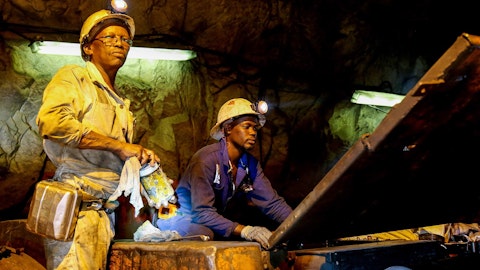David Silver: Yes. So several questions and I’m going to apologize in advance. The wording of these are probably alternatively going to sound like hopelessly naive or, I don’t know, a little snide or whatever, but that’s not my intention. But first was Performance Materials. I mean it seems like there’s been not just good results this year, but an accelerating book of business or successful contract wins. A couple of angles on this. But firstly, do you have a traditional backlog figure for Performance Materials? And maybe how is it looking now compared to, let’s say, maybe the beginning of the year or a year ago, however you typically track it? And then, again, a naive question warning. What would you attribute your seemingly greater success in these new contract wins, particularly, I guess, aerospace and defense?
You’ve always had a commanding position, let’s say, in beryllium in this area. So has there been a shift maybe in your value proposition or the way you go to market? But what would you say is the mix of factors that’s leading to the record performance, but that’s really the symptom of the cause, which is you’re becoming a preferred supplier for these high-value opportunities? So, a long-winded question, but maybe just the mix of factors that are at play here and how — and I’ll just stop there. But yes, the mix of factors you would say?
Jugal Vijayvargiya: Yes. Well, first of all, I think our Performance Materials segment, like you have indicated, has done really, really well. Not only just in the last year, but I think if you look back five, six years and what the business has done in terms of the growth, the top-line growth of the business has achieved as well as the bottom-line performance, the business has done quite well. When you think about, I think, the parts about the new business, so let’s just talk about that first because that you highlighted, what’s different. I would say, I think our team is doing a really, really good job of getting the marketing of our materials out, the great performance, I think, of the materials that we have, the material science expertise that we have.
So our technical sales our business development efforts that we have, I think, across these markets, particularly, I would say, the growth market, so like, for example, space, I mean, so just — we’re highlighting Space today, so I’ll talk about that. But of course, by the way, this applies to all the markets. But understanding our materials, getting our materials out there, helping the customers understand the value of our materials and then providing great value propositions at the end of the day. And I think the team has just done a wonderful job of that. And that, I think, has helped tremendously. So our teams have been focused on understanding what the needs are for the customers and then finding the right solutions for those needs, and they’ve just done a fantastic job of that, which, by the way, kind of leads directly to your question on the backlog.
We do look at backlog. It’s one of the metrics that we look at, but we look at many different metrics, as you can imagine, from our growth perspective. There’s always puts and takes on backlogs. Some of the markets are down like industrial, which we know. Space is a market that’s top. There’s also — our backlog also has a key component of backlog is lead times. If you go back to kind of the ’21, ’22 timeframes, I mean our lead times for some of our materials were extremely long as we were ramping up after the COVID year of 2020, and getting the workforce in. Our lead times have improved significantly, which has, as you can imagine, has a negative impact on backlog, but that doesn’t mean that our business is actually declining. I mean, as you’ve seen, our sales are up.
So, we look at a number of different metrics. I mean backlog is one of the metrics that we look at. But in general, I mean, the teams have been driving more new opportunities in really all the markets using our superior materials.
David Silver: Okay. My next question would be on Electronic Materials. And you have commented on the lingering, I guess, customer inventory issues. I was hoping you could maybe talk about it from a somewhat broader perspective. So, currently, you’ve been spending some discretionary capital to build out your capabilities in that area in Milwaukee, pardon me, and in Newton. And I think you had some expectations for the demand levels for when that new capability is available. And I’m just wondering if you could maybe give us your current thinking about the transition period here, right, maybe the sluggish customer demand, which has persisted a little bit longer maybe than initially thought. But then you also have these new capabilities coming up.
So is it the case where there might be a little bit of a gap when those new units turn on? Or is it the kind of case where the products and services that the newer capabilities are designed to serve are really maybe next generation or not the market end markets or the applications don’t necessarily overlap with where the softness is now? So a long-winded question, but maybe how do you think about this current phase of softer demand in the context of the longer-term growth projections that you’re operating the business under?
Jugal Vijayvargiya: Yes. So if you look at our two facilities that you mentioned, where we’re adding these new capabilities, both in Milwaukee and Newton, our expectation to get the additional volume in place was going to be the second half of 2024, by the time the facilities and the equipment was procured and then we did installation and got the production going. So, I think the timing is actually going to work out just perfect because as the recovery starts to happen here a little bit in Q4, but then into the first half of next year and then a much greater recovery in the back half of ’24 and then into ’25, I think we’re going to be extremely well positioned to be able to deliver the emerging ALD products, that our customers are needing for memory applications, in particular, out of our Milwaukee facility.
And then the logic and memory products out of our Newton facility. So, I think the slowdown is actually, in some respects, you can say, helped us to put our capacities in place. Because what was happening in ’21 and ’22 is we were running all of our plants, basically full. And at the same time, we were trying to figure out how to put these additional capacities in place. The slowdown has given us the opportunity to allocate the resources in the right way to put the capacities in place in Milwaukee and Newton, so that we can have them ready in the back half of ’24 and into ’25, as the recovery is going to come in. So in some respect, David, it’s interesting. The slowdown, I think, has helped us to make sure we’re getting the capacity in, in the right way, and the timing of that, I don’t think is impacted at all.


